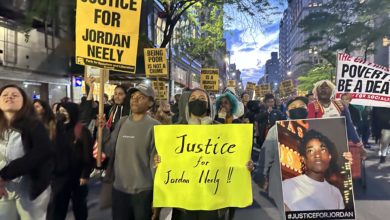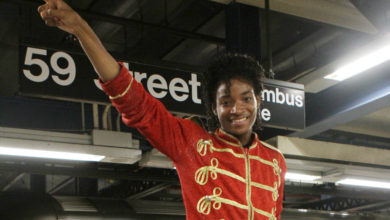 The fight to free the Scottsboro Boys led to major growth for communists in Harlem. |
In the early 20th century, New York City’s Harlem became a Black cultural and political center in the United States. This was largely due to the First Great Migration of the 1920s, when African Americans left the southern states to escape the terror of Jim Crow laws.
The artistic and cultural movement known as the Harlem Renaissance attracted African Americans who sought to develop their intellectual and artistic expressions. The magnificent proliferation of visual, performing and literary arts shattered racist myths and slanderous notions aimed to justify Black oppression.
At that time, the 1917 revolution in Russia had created an impulse towards organization and militancy among socialist militants worldwide. The intertwining of the growth of the U.S. communism and the movement against racism and for Black liberation would have a historic impact on both—and Harlem was at the center.
Socialism and racism
Due to the particularities of the development of U.S. capitalism—including the central role played by slavery and then Jim Crow apartheid—African American involvement in the socialist working-class movement was virtually nonexistent until the 1910s. Socialism had come to the United States primarily through European immigrants who had no experience with the horrors faced by working-class African Americans in the United States.
In fact, around the turn of the 20th century, some white socialists, in the South and the West in particular, discredited the cause by succumbing to blatant racism and discouraging African Americans from joining the Socialist Party.
Such a perspective greatly harmed the cause of working-class solidarity. It undermined the valiant efforts of other white socialists who fought against the dominant racist ideology and advocated unity in the struggle against capitalism.
The central struggle of the Black masses was against racist violence—the abominable practice of lynching in particular—and for basic democratic rights. The ferment among oppressed Black workers was slowly but surely making itself felt throughout the country.
The winds of revolution
The single biggest factor in joining the struggle for Black liberation and the struggle for socialism took place thousands of miles away from Harlem. The formation of the Soviet Union, based on the Leninist principle of self-determination, fueled the social, cultural and economic advance of nationalities that had faced extreme oppression under the Russian empire.
This historic development had two immediate effects in the United States. Firstly, it provided a living example for socialists of unity between workers of different nationalities on the basis of solidarity and rejection of chauvinism. Secondly, it provided a pole of attraction for oppressed nations all over the world—including the Black nation in the United States—to the possibilities of socialism and national liberation.
The latter became apparent in Harlem. Black-oriented socialist literature appeared, including newspapers such as the Messenger, founded in 1917 by A. Philip Randolph and Chandler Owens, and the Crusader, founded in 1918 by Cyril Briggs.
Briggs was also instrumental in forming the African Blood Brotherhood in 1917. The ABB was a secret Black Marxist organization that advocated the right to armed self-defense against KKK terror. The ABB was based in Harlem and had branches in cities throughout the southern United States. Its formation was a milestone, indicating that Black revolutionaries had adopted the tools of scientific socialism in their struggle for liberation.
The African Blood Brotherhood and the Communist Party
By the mid-1920s, the ABB merged with the Communist Party, itself in its infancy after having formed out of the most revolutionary currents from the U.S. socialist and anarchist left. The merge was the first organizational infusion of Black leaders and activists into the CP, although many talented Black leaders like Hubert Harrison, James W. Ford, Benjamin Davis, Harry Haywood and others joined the party as individuals.
The fusion was instrumental in forming the CP’s Harlem section, which gave the CP legitimacy it had not yet achieved in the Black community. The CP was able to engage in both polemics and collaboration with other currents within the Black movement, like the followers of Marcus Garvey’s Universal Negro Improvement Association, which advocated Black self-determination but were not opposed to capitalism.
The ABB’s fusion into the Communist Party also introduced into the latter’s ranks a distinct political tradition. As the leader of the Harlem section of the ABB, Briggs’ organizing focus had always been the Black national liberation struggle rather than the social revolution at large. While Briggs understood the need for multinational unity, differences emerged on several occasions with the national leadership over the extent to which the Party’s tactics in the mass struggle should either utilize, or directly challenge, the community’s historically justifiable suspicion of white people.
On one instance, for example, Briggs energetically took up a “Don’t Buy Where You Can’t Work” campaign initiated by local nationalists, while other Black leaders like James Ford and Harry Haywood argued that campaigns for Black jobs must focus not on small white shopkeepers, but on the big corporations, where greater potential for multinational unity existed. Such controversies led to Briggs’ removal from leadership in Harlem, but he remained an active Party member, and close friend of Haywood, into his 70s.
The Scottsboro case and the 1935 “Harlem Riot”
In 1931, nine adolescents ranging in ages 12 to19 were falsely accused of raping two white women in Scottsboro, Ala. They became known as the Scottsboro Boys. Eight of the Black youths were sentenced to death. Rape was a common accusation used against Black men during the years of Jim Crow and lynching, especially in the old segregationist southern states.
The prominent National Association for the Advancement of Colored People refused to support the Scottsboro Boys, yet that did not prevent Harlem from becoming a stronghold for the national movement demanding their release. This was largely thanks to the efforts of the Communist Party, which emerged at the forefront of a major national struggle for the first time.
The Communist Party was also involved in the cultural development of the Harlem Renaissance. It helped establish and fund cultural organizations like the Federal Negro Theater, the Federal Writers Project and the Harlem Community Arts Center. These projects provided employment for many and gave Black artists a chance to excel.
A major factor in the CP’s credibility with the Black community was the so-called “Harlem Riot”—in reality, a popular uprising against police brutality. On March 19, 1935, the white manager of the Kress Five & Ten store on 125th Street, the commercial center of Harlem, grabbed a Black-Puerto Rican youth named Lino Rivera for allegedly shoplifting.
The police dragged the youth to the basement before releasing him through the back door at the request of the manager. But word spread that the young man had been beaten and killed—a credible story given the police’s record of racist brutality.
Harlem residents gathered in front of the store. The Young Communist League—the CP’s youth organization—and the African American group known as the Young Liberators initiated a demonstration. When police attempted to disperse them, anger erupted into an uprising that consumed most of Harlem, ending with a three people killed, several injured and more than 200 arrested.
The capitalist accused the CP of fomenting racial turmoil, but the CP used the occasion to expose the root causes of Harlem’s high unemployment, inadequate health care, poorly maintained housing and police mistreatment of the Black community.
The Harlem section set new standards for CP chapters throughout the country. Socialism had an unquestionable political and organizational sophistication in Harlem, recruiting thousands of members over the 1930s. By 1939, African American membership in the Communist Party nationally rose between 5,000 and 7,000 members.
The end of an era
In the 1940s and 1950s, Communists in Harlem were well-known for their role in opposing police brutality, housing and job discrimination, and for helping to lead the struggle to integrate Major League Baseball.
During this period, however, the U.S. government unleashed a vicious anti-communist witch-hunt as the domestic component of its crusade against the socialist camp. The persecution was spearheaded by the notorious Sen. Joseph McCarthy, but was ultimately supported by both major parties. Many communists and communist-sympathizes lost their jobs, hundreds were imprisoned and thousands were driven underground or out of politics.
As a leading member of the Communist Party, Black City Council member Benjamin Davis was forced out of his post. The CP’s decline and the witch hunt emboldened privileged elements in Harlem to become vocal anti-communists. They opportunistically aspired to be equals to their white bourgeois counterparts, and consciously attempted to write communists out of Harlem’s long, proud history of struggle.
But the case of Harlem demonstrates the role of Black communists, and the steadfast African American masses, in safeguarding the integrity of and enhancing the U.S. workers’ movement. It is our duty to recover this proud chapter of our past.






